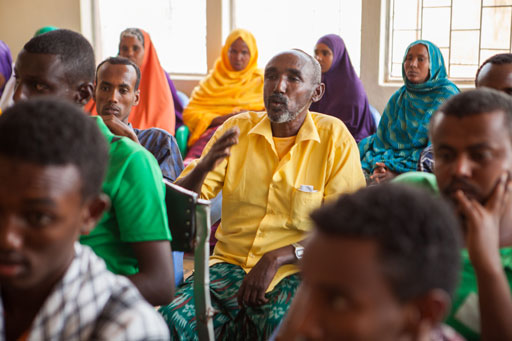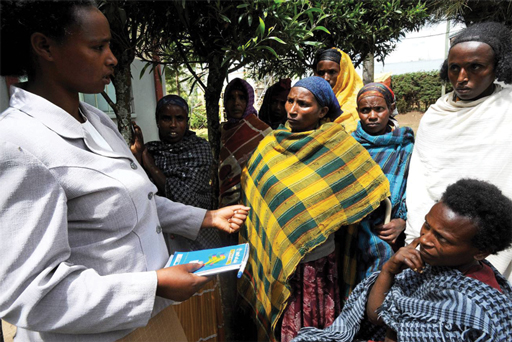14.2 Preparedness phase
Preparing for an emergency means planning ahead so that when disaster strikes, there are systems in place to respond quickly and effectively. Being prepared will save lives and help response and rescue operations. Plans for behaviour communication will be part of a broader preparedness plan that covers all aspects of emergency preparation.
For behaviour communication, preparation follows similar principles to those for behaviour and social change communication that you have read about in previous study sessions. Preparedness for behaviour communication in an emergency situation includes a number of steps, outlined below.
1. Develop a communication plan
The first step is to develop an emergency communication plan. Designing a communication plan should begin with bringing the various stakeholders together to determine the objectives of the plan, the methods to be used and the resources required, including financial and human resources (UNICEF, 2012). The stakeholders could include government, NGOs and community representatives. It is important for community representatives to participate in the planning and decision making so that they can provide information about the local situation as well as develop a sense of ownership of the plan.
Remember that effective behaviour change communication is a two-way process and should be a dialogue between the people giving out the information and those receiving it. Working with communities through a process of dialogue can help identify potential barriers to change and specific cultural and social beliefs and practices which might prevent desired behaviour. Sustained dialogue can help bring about community involvement and participation in addressing the emergency.
The communication plan should also consider the roles and responsibilities of different partners, the results in terms of changed behaviour that it is aiming to achieve, and how those results will be monitored at different phases of the emergency (UNICEF, 2006).
2. Identify communication channels
The communication plan will also need to consider the possible methods to be used for providing information. In an emergency, communications need to reach as many people as fast as possible. It is advisable to use both interpersonal methods and mass media methods during an emergency.
Communications to individuals or small groups are unlikely to have the necessary impact but interpersonal methods that reach large numbers of people such as public meetings will be more effective (Figure 14.4). Other options include public address systems with speakers mounted on vehicles.

Mass media, such as radio, television, text messaging via mobile phones, and newspapers can be useful to raise awareness and can also help promote critical behaviours and disseminate programme information (Figure 14.5). These methods help inform large numbers of people quickly but they often do not provide the opportunity for feedback.
Choosing more than one channel for emergency communication means that messages can be repeated and reinforced and can help ensure that as many people as possible are reached. Mass media methods are most effective when combined with interpersonal methods that allow affected people to discuss the information with someone they trust such as community opinion leaders (UNICEF, 2006).
3. Prepare communication materials and keep them ready to use
Some communication materials can be prepared in advance and stored ready for distribution, as shown in Figure 14.6. These would have to be stocked at the district level, so that during an emergency they can be immediately distributed in the field, saving precious time and resources. It may be possible to prepare electronic copies (soft copies) of materials in draft versions that can be finalised and printed (hard copies) when needed.
In the eventuality that new materials need to be produced, it would also be helpful to create a directory of graphic designers, media producers, radio /TV channel contacts and others who you would need to call on for support if an emergency arose.

4. Train service providers in emergency communication skills
In times of stress and trauma caused by an emergency, community level communicators such as Health Extension Workers (HEWs) and members of the Health Development Army (HDAs) need good interpersonal communication skills to inform, motivate, counsel and encourage affected people and communities. Providing the necessary training on interpersonal communication for these frontline workers is an important preparatory activity.
5. Engage communities in preparing and planning for emergencies
The human rights-based approach, supported by the Sphere standards, stresses participatory approaches that engage communities in planning, implementation and monitoring processes. This means that programmes should build on what people already know, and recognise their social and cultural strengths. An important part of preparation, therefore is gathering information from all members of local communities (Figure 14.7).

Communities are, however, made up of many different types of people. Some people may be less able to take part in decision-making processes due to vulnerabilities related to age, gender inequalities, ethnicity, socio-economic status and disability. In areas that are particularly vulnerable to emergency, supporting communities to develop community action plans themselves is a key preparedness activity. The HEWs and HDAs could be instrumental in developing and supervising the implementation of such a plan.
Explain why the following actions are important parts of preparing for an emergency.
- Create a directory of useful contacts for disseminating emergency communications.
- Train frontline health workers in counselling skills.
The answers are as follows:
- Having a directory of useful contacts for disseminating emergency communications would be helpful if there was an emergency because it would save time and enable messages to be sent out more quickly.
- Training health workers in counselling would ensure they had the necessary skills to support their community in the event of an emergency, especially in terms of psychosocial impact. They would also be able to explain messages sent out by other methods such as radio or TV.
14.1.1 Standards for emergency response

